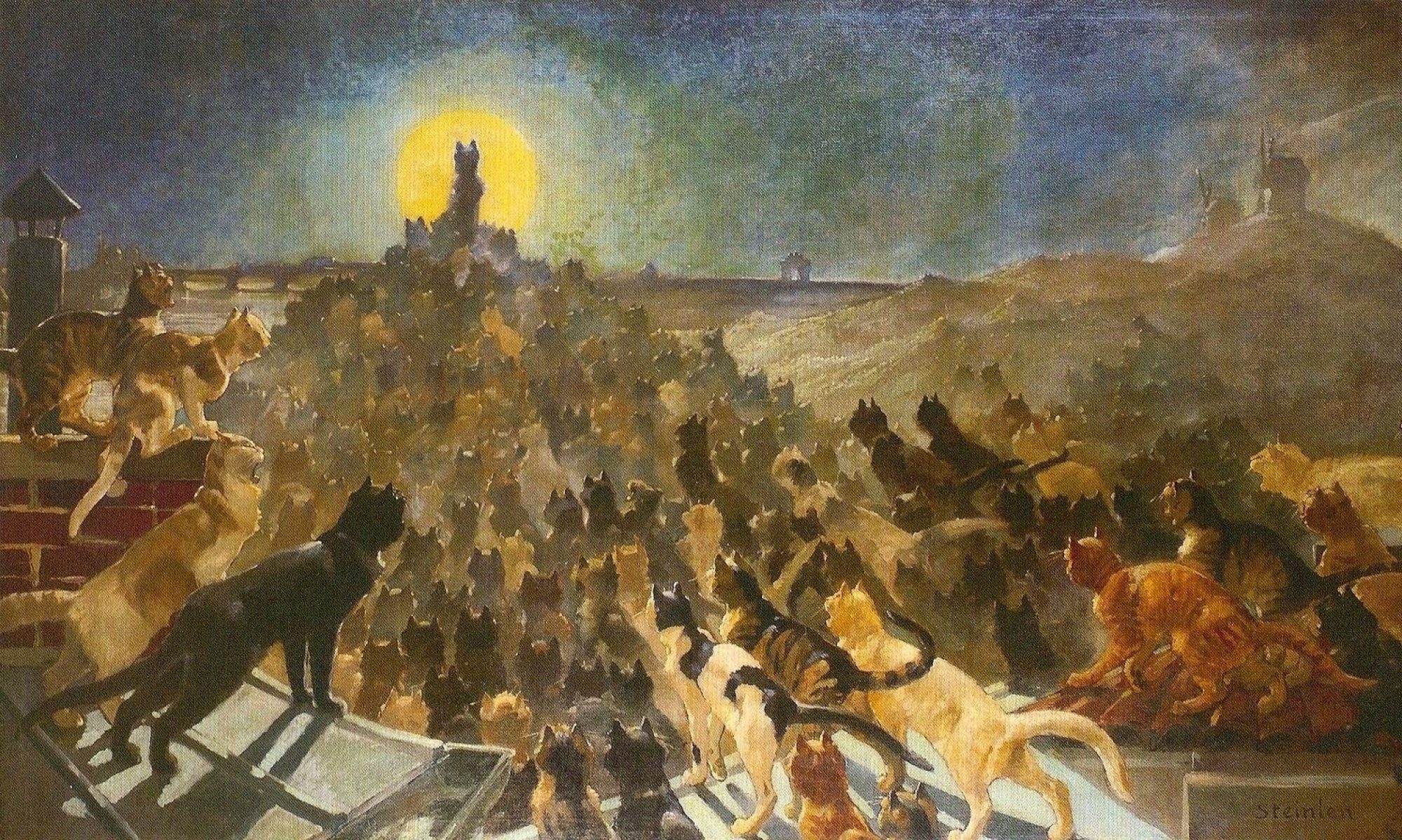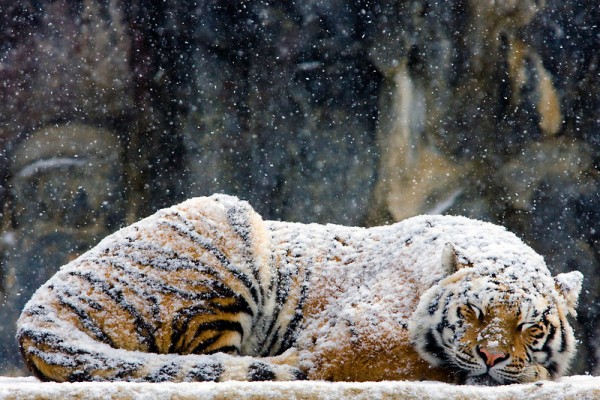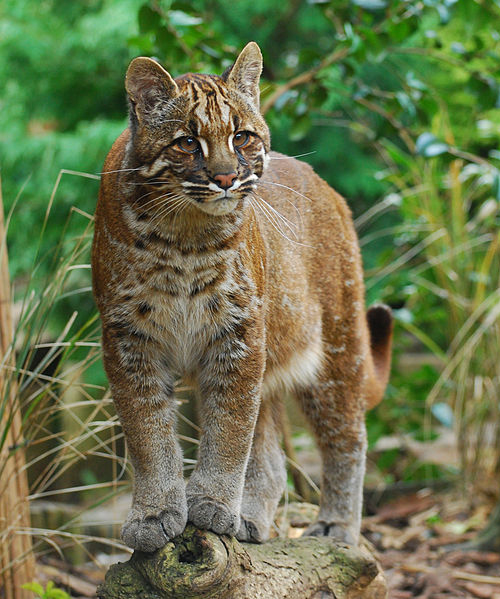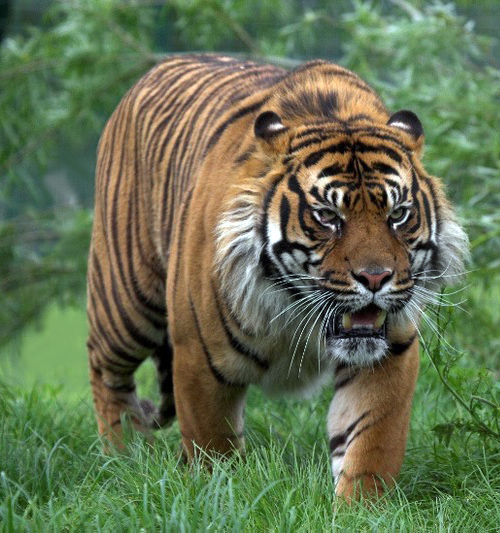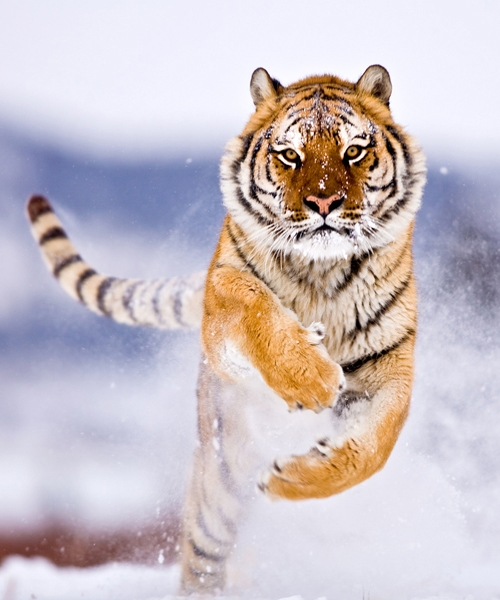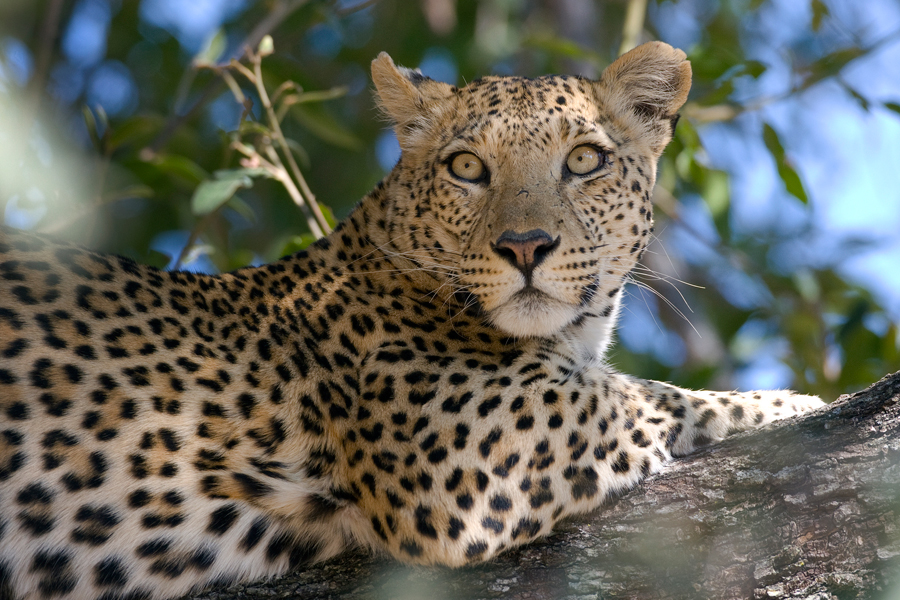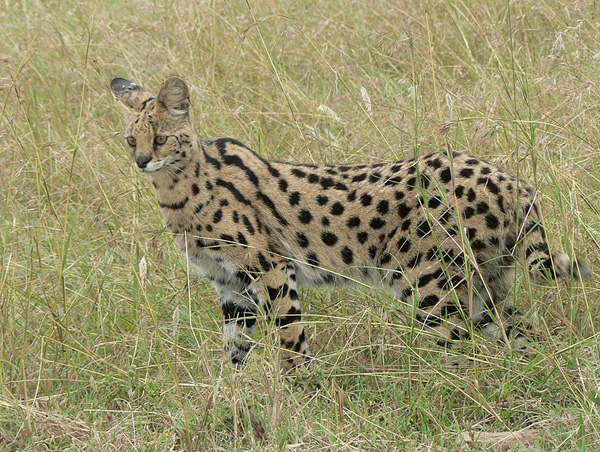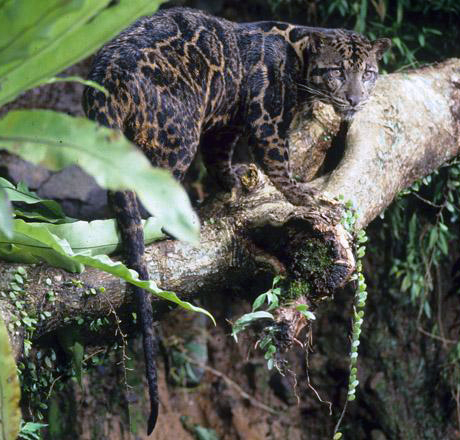The Golden Cat
Golden Cats are sturdy strong felines with long legs and large paws. These creatures are over twice the size of our own domestic cats (at 1 metre long and 45 cms tall). A fully grown adult can weigh 15 Kg or more. Fur can be russet red to golden-brown but may range to black and grey also (leading to the common nickname “Fire Cat” no doubt. Their coat is of moderate length but very thick and generally unmarked, although cats in the more northern regions of Asia (and Africa) are more likely to have spots and stripes which closely resemble the markings of the Leopard. Ironically, this beautiful coat and unique colouring is one of the traits of this animal that places them in the greatest danger.
In Burma and Thailand a golden cat has for centuries been known as a “Fire Cat”. Legend advises that carrying one hair (taken from this animal) will give the bearer protection from tigers! It’s also said that burning a pelt from this cat will drive tigers away from the surrounding area. However, hunting of this cat is banned in a number of countries (and rightly so). With its restricted natural habitat depleting over time, along with the bush meat trade, the African golden cats might soon be in danger.
In parts of China they are known as the “Rock Cat”. They range (in Asia) from Nepal and northeast India through southeast Asia, China, Thailand, Malaysia and Sumatra. Unlike the African cat however, the Asian species is considered to be more abundant throughout their range.
Apart from the (often) red coat the most distinguishing feature of this cat are the white lines bordered with black running across the cheeks, and from the inner corners of the eyes up to the crown. As with many cats, the underside and inner legs are white. The backs of the short, rounded ears are black, with a whitish central area, and the eyes can be usually greyish green or amber.
The African golden cats (Profelis aurata) are found in the humid rain-forest parts of Western and Central Africa and also in the dryer secondary forests of these regions where they can be quite active in the lower part of the tree canopies. They are closely related to their Asian cousins although the two are separated by more than 6,400 kilometers and over a million years of evolution! It is believed that the split in Genes occurred when the forests covering the area from Senegal to China gradually turned to vast deserts. It is believed that over the years the deserts isolated the two Golden Cat populations.
Both the Golden Cat Species resemble the Caracal Cat and also the Serval Cat. They are (similarly) nocturnal forest dwellers, preferring deciduous and tropical rain forest, and occasionally more open areas with rocky tracts. In this terrain their long legs make them highly agile and excellent at climbing trees. Nevertheless, they spend most of their time living on the ground walking on their large paws and curling their striped tails up at the tip.
Continue reading “The Golden Cat”
Tiger
Cat of the Month ~ June 2011
The tiger is the largest of the four Big Cats in the genus Panthera.
Panthera Tigris is native to much of eastern and southern Asia though its range has been diminishing steadily for many years.
The largest (Siberian) tigers measure up to 3.3 metres (11 feet) in total length and weigh up to 300 kilograms (660 pounds). The most numerous tiger subspecies is the Bengal tiger. Tigers have a lifespan of ten to fifteen years in the wild, but can live longer than twenty years in captivity. They are a highly adaptable cat, and range from the Siberian coniferous forests (taiga) to the open grasslands of India and the Indonesian tropical mangrove swamps.
Tigers are territorial and generally solitary animals, requiring large areas of deep dense vegetation (in which to hide and stalk, by means of its camouflaged colouring), proximity to drinking water, and of course an abundance of prey. Tigers are often found bathing in ponds, lakes, and rivers (especially in the heat of the day). Together with the jaguar, the tiger is a strong swimmer and is able to carry large prey animals through water as it swims (no doubt using its sharp teeth (which grow up to 5 inches in length) and extremely strong jaws to grip the prey carcass. Incidentally, the word “tiger” is taken from the Greek word ‘Tigris’, which is possibly derived from a Persian source meaning “arrow”, a reference to the animal’s speed (not its sharp teeth).
Sadly, the tiger is an extremely endangered species, primarily due to human intervention (in deforestation and fragmentation in their habitat and also because of human hunting) but also due to the dangers of everyday existence. For example, only fifty percent of Tiger cubs survive to independence from their mother, which occurs at around two years of age. Also only 40 percent of these survivors live to establish a territory and begin to produce young. The risk of mortality continues to be high even for territorial adults, especially for males, which must defend their territories from other males.
Consequently (with the human threat coupled with the everyday dangers of life) three of the nine subspecies of modern tiger have now gone extinct, and the remaining six are classified as endangered, some critically so.
Tigers are among the most recognisable, and are in fact the most popular, of the world’s animals. They have featured prominently in ancient mythology and folklore, and continue to be depicted in modern texts and videos. Tigers appear on many flags and as mascots for sporting teams. Tigers are the national animal of several Asian nations, including India.
Tigers typically have rusty-reddish to brown coats, a whitish underbelly to rear area and a white ruff that surrounds the lower jaw, neck and chin. Of course the tiger is well known for its stripes. These can vary in colour from brown or grey to pure black. The form and density of stripes differs between all the subspecies (as well as the ground coloration of the fur). The pattern of stripes is unique to each animal, these unique markings can be used by researchers to identify individuals (both in the wild and captivity).. Unusually, the stripe pattern is also found on the skin of the tiger (shown when the fur is removed). It is believed but not proven that most tigers have over one hundred stripes around the body.
Continue reading “Tiger”
African Leopard
Cat of the Month ~ May 2011
The story of how this particular female Leopard came to be up a tree is recounted by Patrick, the photographer:
The African Leopard (Panthera pardus pardus) is a leopard subspecies occurring across most of Sub-Saharan Africa. The International Union for Conservation of Nature (IUCN) classified leopards as Near Threatened in 2009, stating that they may soon qualify for the Vulnerable status due to habitat loss and fragmentation. They are becoming increasingly rare outside protected areas and the population is decreasing gradually. The most secretive and elusive of the large carnivores, Leopards are solitary creatures and predominately nocturnal.
Leopards are known for their ability in climbing (and said to be the strongest climber of the large cats). By climbing, the Leopard can use this vantage point to gain a better view of possible prey in an area. These cats have been observed dragging their kills up trees and hanging them there.
They are powerful runners, reaching speeds of up to 36 mph in the chase. They are also capable swimmers (although not as strong as some other big cats, such as the tiger). They are very agile, and can leap over 6 metres (20 ft) along the ground, and jump up to 3 metres (10 ft) vertically.
Leopards are versatile, opportunistic hunters, and have a very broad diet. They feed on a greater diversity of prey than other members of the Panthera species, and will eat anything from dung beetles to male giant elands, up to 900 kilos in weight. Their diet consists mostly of ungulates (hooved animals) and monkeys, but they also eat rodents, reptiles, amphibians, insects, birds, and fish. In Africa, mid-sized antelopes provide a majority of their prey, especially impala and Thomson’s gazelles.
They have been heard producing a number of vocalizations, including grunts, roars, growls, meows, and “sawing” sounds. To hear some of these recorded sounds you may want to try this link.
Sources : Personal account by Patrick Meier, Wikipedia.org and other Big Cat websites.
Serval Cat of Africa
Cat of the Month ~ March 2011
The Serval (Leptailurus Serval), is a medium-sized African wild cat which has lion and cheetah ancestors. (It is the cheetah which is thought to have descended from ancient Servals).
The serval is native to Africa, where it widely distributed south of the Sahara.
Its main habitat is the savanna, although the light coloured (melanistic) strain of this animal are more usually found in mountainous areas at elevations up to 3,000 Metres or 10,000 ft
The Serval needs rivers and streams within its territory, so it does not live in semi-deserts or dry steppes. Servals also avoid dense equatorial jungles, although they may be found along forest fringes. They are able to climb and swim, but seldom do so.
Servals are nocturnal, and so hunt mostly at night, unless disturbed by human activity or the presence of larger nocturnal predators. Although the serval is specialized for catching rodents, it is an opportunistic predator whose diet also includes birds and small mammals, fish, and frogs. It has also been seen feeding on larger animals, such as deer, gazelle, and springbok. The Serval eats very quickly, sometimes too quickly, causing it to gag and regurgitate due to clogging in the throat. Small prey are though devoured whole. Like many cats, Servals are able to purr. The Serval also has a high-pitched call, and can hiss, cackle, growl and meow.
As part of its adaptations for hunting in the savannas, the Serval has extremely long legs (the longest of all cats, relative to body size) for jumping, which also help it achieve a top speed of 80 kilometres per hour (50 mph).
The long legs (and neck) also allow the Serval to see over tall grasses, while its very large ears are used to detect prey, even those burrowing underground. Servals have been known to dig into burrows in search of underground prey, and to leap 2 to 3.6 metres into the air to grab birds in flight or to pounce on ground prey. While hunting, the Serval may pause for up to 15 minutes at a time to listen with eyes closed.
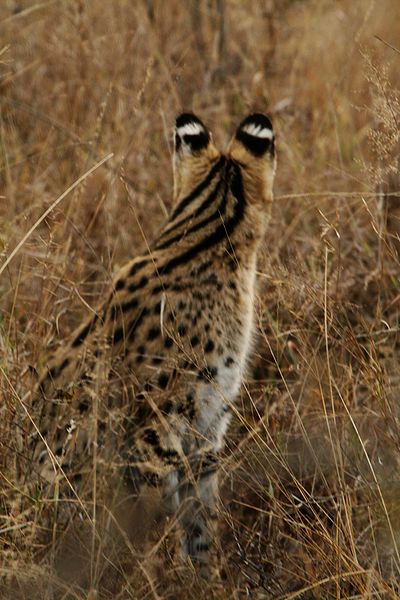
The eyespot markings or ocellus are used to signal
to Serval kittens when hunting.
The Serval then is an proficient killer, catching prey on an average of 50% of attempts (with a 67% success rate at night), compared to around one in ten attempts for most species of cat.
Servals are extremely intelligent, and demonstrate remarkable problem-solving ability, making them notorious for getting into mischief, as well as easily outwitting their prey, and eluding other predators. The Serval will often play with its captured prey for several minutes, before consuming it (where have we seen that before, Ed.). In most situations, Servals will ferociously defend their food against attempted theft by others. Males can be more aggressive than females.
Clouded Leopard
Cat of the Month ~ February 2011
Until 2006, there was thought to be a single clouded leopard species (Neofelis nebulosa). However, recent genetic and morphological studies have led researchers to conclude that there are two completely separate species of clouded leopards. Researchers estimate that the two species diverged approximately 1.5 million years ago due to geographical isolation.
Officially recognised as new species of Clouded Leopard (Neofelis diardi or ‘the Sundaland clouded leopard’) in March 2007, these cats were discovered on the Indonesian islands of Borneo and Sumatra. Sadly these cats are already on the endangered species list, with an estimated 18,000 of them remaining in the wild.
If you would like to find out more please visit the following websites
The National Geographic Big Cats Initiative
The Clouded Leopard Project Leopard Conservation & Research.
Cougar
Cat of the Month ~ September 2009

The Cougar is also known as puma, mountain lion, Catamount, or panther, depending on the region in which it is identified, is a mammal of the Felidae family (in other words it’s a Cat :yes: ahem..), native to the Americas.
This large, solitary creature has the greatest range of any large wild terrestrial mammal in the Western Hemisphere, extending from Yukon in Canada to the southern Andes of South America. An adaptable, generalist species, the cougar is found in every major American habitat type. It is the second heaviest cat in the American continents after the jaguar, and the fourth heaviest in the world, along with the leopard, after the tiger, lion, and jaguar, although it is most closely related to smaller felines.
The genus and species name is said to mean ‘a cat of one color’, describing the almost single colored coat. Coat colors range from tan to dark brown, depending on the region. Coat thickness also varies. Kittens are born with spotted coats as are lion cubs. They also have the distinguishing black face marks and tail tip. As the young cougar matures, it will lose it’s spots for an adult coat. Cougars range in size from five to eight feet long, and from about 60 to 225 lbs. Males are almost twice as large as females.
A capable stalk-and-ambush predator, the cougar pursues a wide variety of prey. Primary food sources include deer, elk, and bighorn sheep, as well as domestic cattle, horses, and sheep, but it also surprisingly hunts species as small as insects and rodents. Moreover, it prefers habitats with dense underbrush and rocky areas for stalking, but it can live in open areas.
Continue reading “Cougar”
